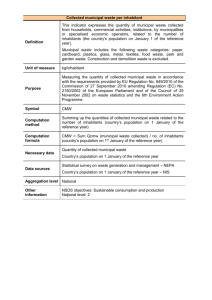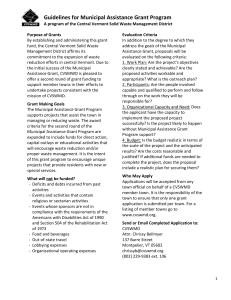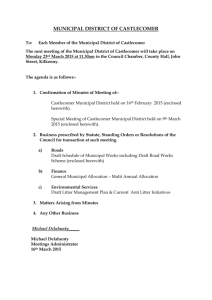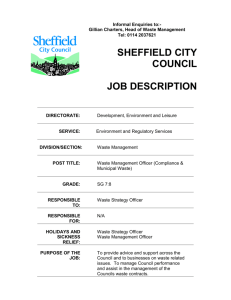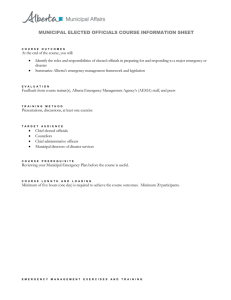Town of Apple Valley
advertisement
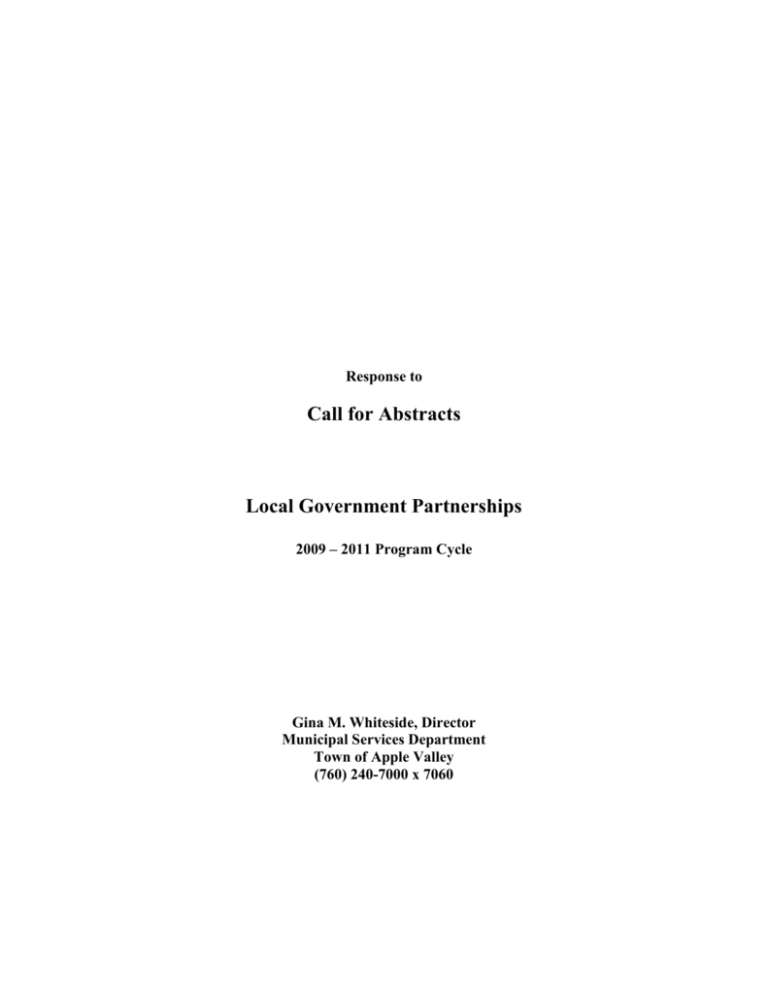
Response to Call for Abstracts Local Government Partnerships 2009 – 2011 Program Cycle Gina M. Whiteside, Director Municipal Services Department Town of Apple Valley (760) 240-7000 x 7060 Part 1 Partner Information a. Town of Apple Valley b. New Local Government Partner c. Gina Whiteside, Director of Municipal Services 14955 Dale Evans Parkway Apple Valley, CA 92307 760-240-7000 x 7060 ginawhiteside@applevalley.org Part 2 a. Proposal Summary and Budget Allocation The scope is construction of a new municipal facility and upgrading the current design (now on the drawing board) to include energy efficiencies in every possible area. The facility under design is a Municipal Services building which will house administrative staff, the Code Enforcement Division and the Animal Control Division, including an animal shelter which will allow for indoor and outdoor sheltering of impounded animals. With the participation of Southern California Edison, the Municipal Services building could become a regional demonstration project spotlighting cutting-edge energy saving features for commercial buildings. The project would reduce energy costs to the public for the life of the building. b. The Town of Apple Valley has already planned to spend $10 million to construct the new facilities. This contemplated partnership would enable incorporation of additional energy-saving “green” features that are currently beyond the municipality’s ability to fund. The animal shelter is now being housed in a converted older residence, remodeled 2 to accommodate the required office, public counter, and medical areas, along with indoor kennels for small impounded animals. Table 3-1 Energy Savings and Demand Reduction Forecast Year #1 – Year #3 Installation Goals Gross Peak Demand Reduction (kW) Unknown Gross Energy Savings (kWh) Unknown Gross Therm Savings (therms) Unknown Table 3-2 Overall Budget Allocation Utility: Southern California Edison Program Budget ($) (%) Administrative Costs 70,000 1.75% Marketing/Outreach Costs 30,000 .25% $4,000,000 98% $4,100,000 100% Item Incentive/Rebate Costs Direct Implementation Costs Total Part 3 Item A - Cost Efficiency Table 3-3 Budget (Resource and Non-resource Activities) Year #1 – Year #3 Item 1 Total Resource Activity Budget $ $14,000,000 2 Total Resource Activity Budget Sponsored by Partner $10,000,000 3 Non-resource Activity Budget $200,000 4 Total Non-resource Activity Budget Sponsored by Partner $100,000 Total Proposed Budget to IOU (1-2+3-4) $4,100,000 3 This partnership would enable the Town to construct and install state-of-the-art energysaving features that are well beyond the reach of its current construction budget. Demolishing the older converted residence, which lacks even common energy-saving features, and constructing a purpose-built facility to energy standards at least 10% over current Title 24 energy standards will realize some energy savings in and of itself. However, Southern California Edison’s participation and expertise would make possible the implementation of even more sustainable elements to the construction which would effectively lower utility costs and energy expenditures for the life of the facility. Item B - Skill and Experience Apple Valley has been incorporated for less than 20 years, but in that time the population has grown from an initial number of about 40,000 to over 75,000. Most of the growth has occurred within the past five years. Although a comparatively young city, Apple Valley’s leadership has made providing public services and leveraging public funds a priority. Since 2001, Apple Valley has received over $10,029,516 in grants from various public and private agencies, each with its own reporting, auditing and compliance standards. Development of energy efficiencies and alternative energy programs are vital to the desert where extreme temperatures summer and winter make for higher utility demand. Wind turbines are the primary alternative energy forms seen in the region, and these receive resistance from those who enjoy desert landscapes. Item C - Demonstrated Commitment In 2007, the Town Council passed a Zero Waste Resolution, indicating its intent to reduce waste of materials, energy and other resources. The Municipal Services Manager has been responsible since 1998 for waste reduction, recycling, the household hazardous materials 4 program, electronic waste recycling, developing organics waste reduction programs and other environmentally-focused topics. The current plans for the Municipal Services building incorporate as many sustainable and energy efficient design features as possible, given current funding constraints. Partnership with Southern California Edison would allow for exploration of additional solar power uses and photovoltaic panels, radiant heat features for the kennels, on-demand water heating and possibly other newer energy-saving technologies that have yet to be demonstrated in the high desert. Application for a Community Action for Renewed Environment (CARE) grant has just been submitted to the U.S. EPA seeking funding to establish a long-term community focus group specifically to address, prioritize and seek to mitigate environmental hazards in the area. Input from the focus group will help bring regional environmental issues into focus and identify the relative importance of each to the citizenry. This in turn will assist local government in understanding the residents’ views, prioritizing which environmental issues should be addressed first, and articulating various responsibilities in helping to mitigate them. Item D - Partner’s Municipal Facilities and Infrastructure In 2002, construction was completed on the first Town Hall building. Prior to this time, local government staff worked out of older, rented facilities. The Town Hall building makes the most use of natural light with clerestories, electronic window coverings, incorporates circulating fans and uses a thermostatic system controlled by a computer program and linked to building security settings to reduce use of utilities when the building is vacant. Town Hall also has two shower facilities and an on-demand hot water system. The current Municipal Services building, finished and occupied in 2006, accommodates the Municipal Services administrative staff, the Code Enforcement Division and the Police 5 Department. To the features previously mentioned, the Municipal Services building added motion-activated sensors to control lighting and further reduce utility use. The current Animal Control/Animal Shelter is now being housed in an older residence lacking even standard energy efficient features. The building was retrofitted to accommodate the necessary offices, public counter, and medical areas along with kennels for impounded animals. The new purpose-built Municipal Services building will provide all the offices necessary for Municipal Services, Code Enforcement and Animal Control staff, as well as veterinary medical areas, indoor kennels, outdoor kennels and corrals, plus an enlarged public education and viewing area in the lobby. Many other energy-saving features might be incorporated into this building design, the plans of which are still being finalized. The roofed kennel areas could be ideal sites for photovoltaic panels. An ice-storage system could be linked to the HVAC system to reduce peak hour demand for electricity. A new system for radiant heat might be designed to run through the kennel floors, providing significant utility savings. An on-demand hot water system for Animal Control’s laundry would also provide savings proportionate to the large volume of animal bedding that must be kept clean. Item E - Feasibility The new combined Municipal Services/Code Enforcement/Animal Shelter building is anticipated to meet community needs for the next 20 years. The new facility that is now being drawn is designing for energy savings that are 10% beyond standard Title 24 requirements. Annual energy use by the current facilities scheduled for demolition was 442,585 kWh and 4,859 therms in 2007. Precise energy savings for the new building cannot be calculated at this time, 6 because they are predicated on the number of additional energy saving features that partnership with Southern California Edison could make possible. Because of its position in the community, the new building with its animal exhibits will be in an invaluable outreach position to demonstrate to the community some of the possible energy savings features available. To the best of our knowledge, there are no certified LEED buildings or structures in the high desert, and no showcase location that deliberately demonstrates and highlights energy efficiencies and alternative energy approaches. Item F - Integrated Approach The proposed partnership seeks assistance from Southern California Edison to recommend, engineer, purchase and install photovoltaic panels to achieve maximum efficiencies from the desert sun to contribute toward the power needs of the new building. In addition to normal office building electricity requirements, Animal Control requires large refrigeration units for storage of carcasses awaiting transportation. These require significant amounts of power and the photovoltaic panels could provide an excellent additional source of power for their operation. Another component for the building would be an on-demand water heating system sufficient to provide hot water for all the building, including meeting the Animal Control/Animal Shelter laundering needs. A radiant heat feature for the floor of the kennel area is a possible feature that would require significantly less energy yet keep the kennel areas sufficiently warm for the animals’ health and well-being, as opposed to conventional natural gas heat or space heaters. A new feature for the building that will be unique to the high desert – perhaps to all of Southern California – is the planned lobby area. Aviary and reptile viewing areas are drawn as part of the entrance to the Animal Shelter/Animal Control section. It is contemplated that this 7 “mini-zoo” feature will draw visitors from throughout the region and serve as an outreach tool for the general public as well as school classes. The Animal Control and Shelter already receive approximately 80 visits a day. This unusual visual feature will attract even more visitors, possibly schools groups, and provide additional opportunities to share the new and exciting sustainable features of the building. The amount of $100,000 has been arbitrarily broken out as being budgeted for public education on energy savings over the next three years. Public education on waste reduction, however, is an ongoing responsibility of the Municipal Services Department along with promotion of sustainable living. Item G- Comprehensiveness While lighting, electricity and natural gas utilities may all be part of sustainable building, specialized input and engineering is required to balance all of these to achieve maximum efficiency. By adding design components at the beginning of the drawing process, care can be taken not to miss any opportunities for energy savings. Southern California Edison’s participation would enable the architects to incorporate recommended features now, well before the actual construction phase, instead of trying to add features at some point in the future. Semi-permeable pavement, where feasible, building orientation, lighting, and insulation appropriate for the desert climate are already components of the new building plan. The building is being designed to achieve 10% over Title 24 energy requirements. The partnership sought with Southern California Edison could enable integration of an ice-storage component (such as Ice Bear ©) with the HVAC system and shift energy demand from peak day time use to night time. Such systems purport to reduce peak energy demand by 95%. 8 The independent utility partner would be asked to recommend, engineer and purchase appropriate photovoltaic panels for the structures that would contribute to the building’s power needs. The partnership might also allow incorporation of additional features such as a radiant floor heating system for the kennel, which could represent a significant savings over conventional natural gas heating. All of these energy savings features require more engineering and capital investment than can be provided by the Town of Apple Valley. While architects have already been asked to engineer the building roofs to support photovoltaic panels in the future, partnership with a utility would allow these features to be installed now and achieve longer cost savings. Item H- Innovation and Reflects the Strategic Planning Process This may be the first building with an Animal Control/Shelter component to be designed with energy conservation and efficiency in the forefront. According to the US Green Building Council, only 158 buildings are LEED-certified in California. None of the listed projects appears to have an animal care component. A partnership with Southern California Edison would enable Apple Valley to add energy-savings measures at the inception of construction that would otherwise be cost-prohibitive to local government in its ongoing effort to make the best use of taxpayer dollars. In terms of innovation, the utility is undoubtedly better informed of new technologies than the applicant. In San Francisco, Norcal Waste Industries is exploring the possibility of methane production from animal waste in connection with a dog park. If such an approach is remotely feasible, the Town would have no objection to experimenting with such a project. There may also be innovative approaches to backup power generation which is an important feature for the animal shelter. 9

